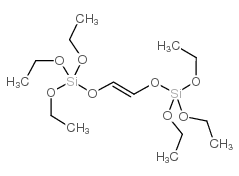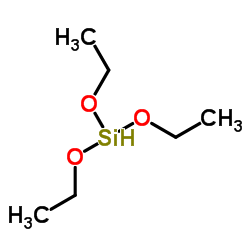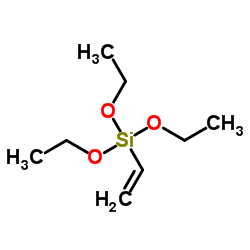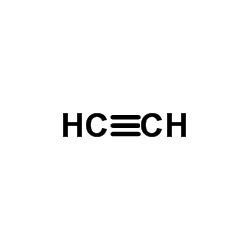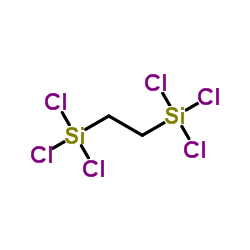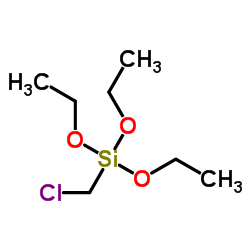16068-37-4
| Name | 1,2-Bis(triethoxysilyl)ethane |
|---|---|
| Synonyms |
Ethylenebis(triethoxysilane)
EINECS 240-212-2 triethoxy(2-triethoxysilylethyl)silane 3,8-Dioxa-4,7-disiladecane, 4,4,7,7-tetraethoxy- 4,4,7,7-Tetraethoxy-3,8-dioxa-4,7-disiladecane 1,2-Bis(triethoxysilyl)ethane MFCD00239362 |
| Density | 1.0±0.1 g/cm3 |
|---|---|
| Boiling Point | 315.0±25.0 °C at 760 mmHg |
| Melting Point | -30ºC |
| Molecular Formula | C14H34O6Si2 |
| Molecular Weight | 354.587 |
| Flash Point | 125.3±23.6 °C |
| Exact Mass | 354.189392 |
| PSA | 55.38000 |
| LogP | 3.55 |
| Vapour Pressure | 0.0±0.6 mmHg at 25°C |
| Index of Refraction | 1.427 |
| Water Solubility | Soluble in alcohol, aromatic and aliphatic hydrocarbons. Hydrolyzes with water. |
|
1,2-Bis(triethoxysilyl)ethane
SAFETY DATA SHEET Section1. IDENTIFICATION Product name:1,2-Bis(triethoxysilyl)ethane Section2. HAZARDS IDENTIFICATION GHS classification
PHYSICAL HAZARDSNot classified
HEALTH HAZARDS Skin corrosion/irritationCategory 2 Category 1 Serious eye damage/eye irritation ENVIRONMENTAL HAZARDSNot classified GHS label elements, including precautionary statements Pictograms or hazard symbols Signal wordDanger Hazard statementsCauses skin irritation Causes serious eye damage Precautionary statements: Wash hands thoroughly after handling. [Prevention] Wear protective gloves/eye protection/face protection. IF IN EYES: Rinse cautiously with water for several minutes. Remove contact lenses, [Response] if present and easy to do. Continue rinsing. IF ON SKIN: Gently wash with plenty of soap and water. If skin irritation occurs: Get medical advice/attention. Take off contaminated clothing and wash before reuse. Immediately call a POISON CENTER or doctor/physician. Section3. COMPOSITION/INFORMATION ON INGREDIENTS Substance/mixture:Substance Components:1,2-Bis(triethoxysilyl)ethane Percent:>95.0%(GC) CAS Number:16068-37-4 Synonyms:Ethylenebis(triethoxysilane) C14H34O6Si2 Chemical Formula: Section4. FIRST AID MEASURES Inhalation:Remove victim to fresh air and keep at rest in a position comfortable for breathing. Immediately call a POISON CENTER or doctor/physician. 1,2-Bis(triethoxysilyl)ethane Section4. FIRST AID MEASURES Skin contact:Remove/Take off immediately all contaminated clothing. Gently wash with plenty of soap and water. Immediately call a POISON CENTER or doctor/physician. Eye contact:Rinse cautiously with water for several minutes. Remove contact lenses, if present and easy to do. Continue rinsing.Immediately call a POISON CENTER or doctor/physician. Ingestion:Get medical advice/attention if you feel unwell. Rinse mouth. A rescuer should wear personal protective equipment, such as rubber gloves and air- Protection of first-aiders: tight goggles. Section5. FIRE-FIGHTING MEASURES Suitable extinguishingDry chemical, foam, carbon dioxide. media: Unsuitable extinguishing Water (It may scatter and spread fire.) media: Specific hazards arising Take care as it may decompose upon combustion or in high temperatures to from the chemical:generate poisonous fume. Precautions for firefighters: Fire-extinguishing work is done from the windward and the suitable fire-extinguishing method according to the surrounding situation is used. Uninvolved persons should evacuate to a safe place. In case of fire in the surroundings: Remove movable containers if safe to do so. Special protectiveWhen extinguishing fire, be sure to wear personal protective equipment. equipment for firefighters: Section6. ACCIDENTAL RELEASE MEASURES Personal precautions,Use personal protective equipment. Keep people away from and upwind of spill/leak. protective equipment and Ensure adequate ventilation. Entry to non-involved personnel should be controlled emergency procedures: around the leakage area by roping off, etc. Environmental precautions: Prevent product from entering drains. Methods and materials for Absorb spilled material in a suitable absorbent (e.g. rag, dry sand, earth, saw-dust). containment and cleaning In case of large amount of spillage, contain a spill by bunding. Adhered or collected up: material should be promptly disposed of, in accordance with appropriate laws and regulations. Section7. HANDLING AND STORAGE Precautions for safe handling Technical measures:Handling is performed in a well ventilated place. Wear suitable protective equipment. Prevent generation of vapour or mist. Wash hands and face thoroughly after handling. Use a ventilation, local exhaust if vapour or aerosol will be generated. Advice on safe handling: Avoid contact with skin, eyes and clothing. Conditions for safe storage, including any incompatibilities Storage conditions:Keep container tightly closed. Store in a cool and dark place. Store under inert gas. Protect from moisture. Store away from incompatible materials such as oxidizing agents. Moisture-sensitive Packaging material:Comply with laws. Section8. EXPOSURE CONTROLS / PERSONAL PROTECTION Engineering controls:Install a closed system or local exhaust as possible so that workers should not be exposed directly. Also install safety shower and eye bath. Personal protective equipment Respiratory protection:Vapor respirator. Follow local and national regulations. Protective gloves. Hand protection: Eye protection:Safety glasses. A face-shield, if the situation requires. 1,2-Bis(triethoxysilyl)ethane Section8. EXPOSURE CONTROLS / PERSONAL PROTECTION Skin and body protection: Protective clothing. Protective boots, if the situation requires. Section9. PHYSICAL AND CHEMICAL PROPERTIES Physical state (20°C):Liquid Clear Form: Colour:Colorless - Almost colorless No data available Odour: pH: No data available Melting point/freezing point:No data available Boiling point/range:88°C/0.003kPa Flash point:No data available Flammability or explosive limits: Lower:No data available Upper:No data available Relative density:0.97 Solubility(ies): [Water]No data available [Other solvents]No data available Section10. STABILITY AND REACTIVITY Chemical stability:Stable under proper conditions. Possibility of hazardous No special reactivity has been reported. reactions: Incompatible materials: Oxidizing agents Hazardous decomposition Carbon monoxide, Carbon dioxide, Silicon oxides products: Section11. TOXICOLOGICAL INFORMATION Acute Toxicity:No data available Skin corrosion/irritation: No data available Serious eyeNo data available damage/irritation: Germ cell mutagenicity: No data available Carcinogenicity: No data available IARC = NTP =No data available Reproductive toxicity:No data available RTECS Number:JG7755000 Section12. ECOLOGICAL INFORMATION Ecotoxicity: No data available Fish: Crustacea:No data available No data available Algae: Persistence / degradability: No data available No data available Bioaccumulative potential(BCF): Mobility in soil Log Pow:No data available Soil adsorption (Koc):No data available Henry's LawNo data available constant(PaM3/mol): 1,2-Bis(triethoxysilyl)ethane Section13. DISPOSAL CONSIDERATIONS Recycle to process, if possible. Consult your local regional authorities. You may be able to burn in a chemical incinerator equipped with an afterburner and scrubber system. Observe all federal, state and local regulations when disposing of the substance. Section14. TRANSPORT INFORMATION Hazards Class:Does not correspond to the classification standard of the United Nations UN-No:Not listed Section15. REGULATORY INFORMATION Safe management ordinance of dangerous chemical product (State Council announces on January 26, 2002 and revised on February 16,2011): Safe use and production, the storage of a dangerous chemical, transport, loading and unloading were prescribed. SECTION 16 - ADDITIONAL INFORMATION N/A |
| Symbol |


GHS05, GHS07 |
|---|---|
| Signal Word | Danger |
| Hazard Statements | H315-H318-H335 |
| Precautionary Statements | P261-P280-P305 + P351 + P338 |
| Personal Protective Equipment | Eyeshields;full-face respirator (US);Gloves;multi-purpose combination respirator cartridge (US);type ABEK (EN14387) respirator filter |
| Hazard Codes | Xi: Irritant; |
| Risk Phrases | R36/37/38;R41 |
| Safety Phrases | 26-36 |
| RIDADR | UN 2810 |
| WGK Germany | 3 |
| RTECS | JG7755000 |
| HS Code | 2931900090 |
| Precursor 8 | |
|---|---|
| DownStream 0 | |
| HS Code | 2931900090 |
|---|---|
| Summary | 2931900090. other organo-inorganic compounds. VAT:17.0%. Tax rebate rate:13.0%. Supervision conditions:AB(certificate of inspection for goods inward,certificate of inspection for goods outward). MFN tariff:6.5%. General tariff:30.0% |



